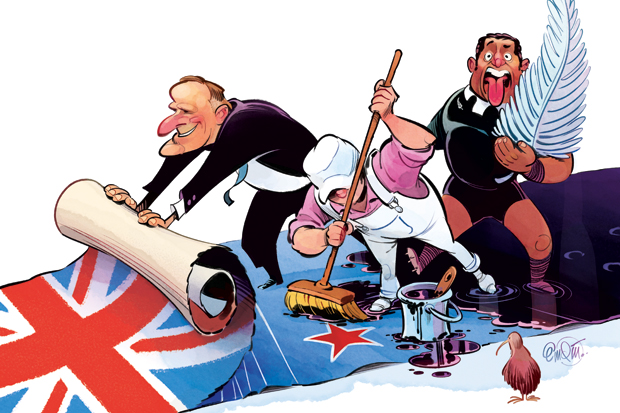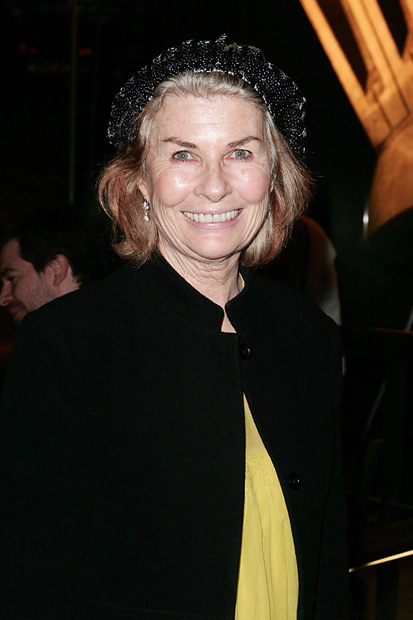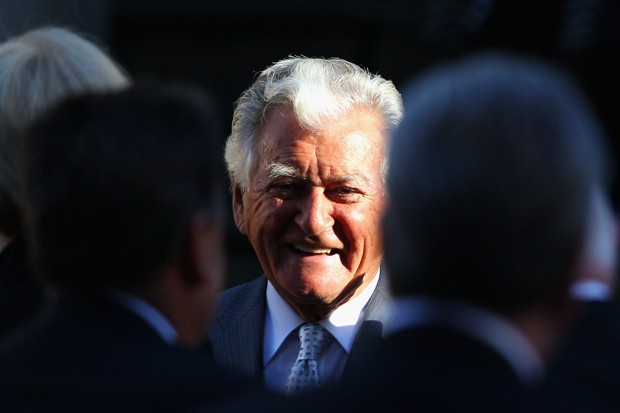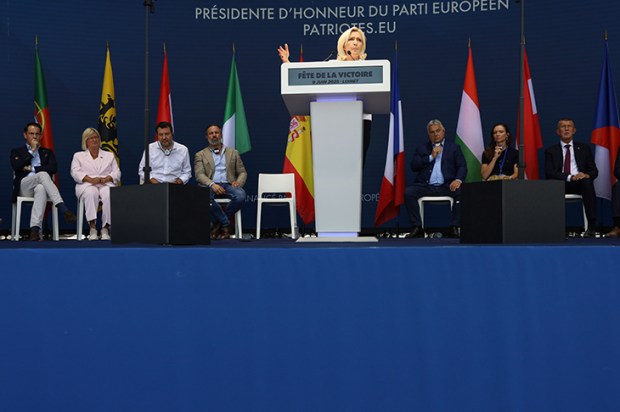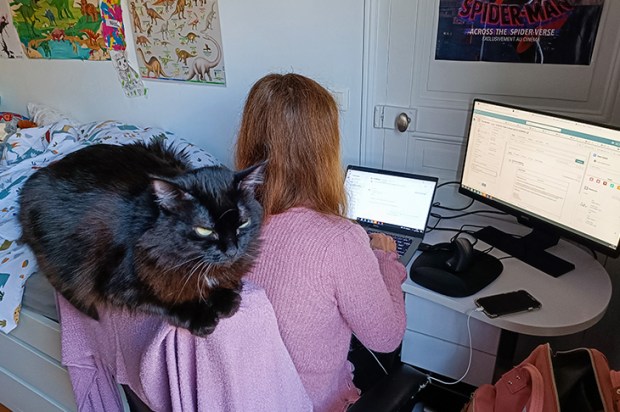Kate Middleton’s arrival in New Zealand on Monday wasn’t the most flawless entrance she’s ever made. A stiff republican breeze buffeted her as she, Prince William and their son, Prince George, stepped off their plane. The weather ensured that Kate’s first official act in the land of the long white cloud ran as follows: check hair; hold support rail; check hair again; smooth hemline; back to support rail. While one hand chased physical perfection, the other was left holding the baby.
Kate’s frantic patting and preening was a depressing spectacle and a visceral analogy for what she’s become since marrying William three years ago: a towering neon visual cue (six foot in heels, to be exact) who doesn’t want to flicker even for a millisecond. She is the lead character in that time-old tale, The Princess and the Patriarchy. It’s just like the original story, The Princess and the Pea, except that, in the real-life version, that nagging feeling poking through the layers of privilege and prestige isn’t a pea, but the arthritic claws of an archaic tradition which points to three steadfast rules: wife, womb, wardrobe — in that order, please.
Those are still the core values impressed upon Windsor wives at the expense of all others. If you don’t believe it, just watch the Duchess’s entrance in Wellington. It’s right there in black and white (accessorised with a genius dash of red).
Kate, an intelligent, modern, Topshop-loving commoner with a degree in Art History, has shackled herself to these three principles, and it’s been wildly successful from the establishment’s point of view. Her glamorous presence has been key in winning over Commonwealth countries like Australia, whose eyes had previously been roving all over the charms of Republicanism not so long ago. How else does one explain why the Australian mentality slid from 1999’s heated republican referendum to the current day, dreamy state which is about to wave the British monarchy’s poster girl in amid a sea of hyperbolic headlines and shameless sycophancy? Is a pretty Duchess of Cambridge, her nice clothes and cute baby really all it takes to distract Australia from further pursuit of a pertinent constitutional issue? Really?
So yes, Kate is great news for the patriarchal establishment she’s chosen to service with a smile. For modern feminism, meritocracy and sheer common sense, not so much. Back home, she’s part of a trend: a generation of European heirs who have bust a gut to marry commoner women with careers, life experience and strong characters. Spain’s Crown Prince Felipe married the frightfully confident former TV journalist, Letizia Ortiz; Willem-Alexander of the Netherlands threatened to renounce the throne he currently sits on for the flamboyant ex-financier Maxima Zorreguieta; Crown Prince Haakon of Norway risked the same fate after falling in love with the divorced single mother Mette-Marit Tjessem Høiby. And, of course, there’s ‘our Mary’, the ice-cool Tasmanian whose marriage to Prince Frederik of Denmark will see her become queen one day.
Kate pales in comparison to her counterparts, all of whom constantly strong arm the modern woman/monarchy conundrum and who clearly carry out their roles on their terms — even when it causes controversy. Argentine-born Maxima, currently the Netherlands’ much-loved Queen Consort, flounced into the doubtful country declaring: ‘I am Latin and I will continue being Latin in respect to some aspects of my culture. I dance, I sing and I will keep on dancing and singing.’ In 2012, Mette-Marit created some heat in Norway when she flew to New Delhi to babysit the surrogate twins of her friends (a same-sex couple) after their travel plans were delayed. ‘There were two newborn babies who lay alone in a hospital in Delhi. I was the one who was able to travel,’ she said via a curt official missive displaying her words and her name alone.
These royal women aren’t apologetic. They push back against tradition when it grips them too tight. They combine style with substance and, most important, they still get the job they inherited done effectively. That’s what modernisation looks like. That’s how the commoner-turned royal should be and here’s what: the new generation of heirs obviously agree because if they didn’t, they wouldn’t have invited so much colour into their lives in the first place or fought to keep it when the public threatened to take it away.
To be fair to Kate, she’s relatively new to the job compared to the European princesses. But even though she’s the new girl, she’s the most influential and the rhetoric around her urgently needs to change. It’s three years to the month that she married, and this tour should be the perfect opportunity to pipe up and show what she stands for beyond her favourite designers.
But she can’t do it alone. The media needs to stop breaking her down into component parts, and prioritising her ‘glossy locks’ and ‘gorgeous’ clothing at every opportunity. There should be an absolute ban on the words ‘glowing’ and ‘radiant’, or news outlets hanging serious engagements, like the royal couple’s planned visits to Uluru, Christchurch or the Anzac Day march, on fashion angles.
From the Palace’s perspective, it would mean trusting Kate with the lead and giving her the chance to talk about what she knows; wouldn’t it be fascinating to hear an Art History graduate’s thoughts on Uluru’s Aboriginal art vs the National Portrait Gallery in Canberra, for example?
Just give us something, anything which provides a glimpse of Kate’s personality and let us all hear the sound of her voice. We know it’s in there and in the modern day, when most royal women have past lives to draw from, this can and should happen. It’s shameful and wrong to stifle a person for the sake of ‘The Firm’.
The next two weeks will be telling, but the most likely scenario will probably see Kate existing largely in the context of Princes William and George. If that happens, the least we can hope for is good weather, if only to ensure there is no repeat of that entrance in Wellington, which clearly showed a woman beginning to internalise the inane, outdated discourse which surrounds her.
Got something to add? Join the discussion and comment below.
Andrea Maltman is a Scottish, Melbourne-based writer.
You might disagree with half of it, but you’ll enjoy reading all of it. Try your first month for free, then just $2 a week for the remainder of your first year.


